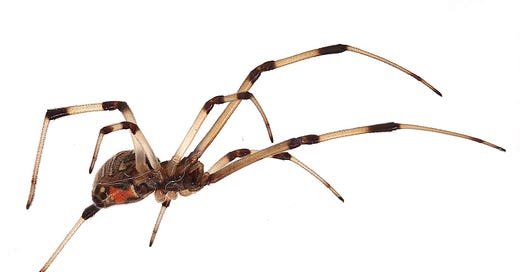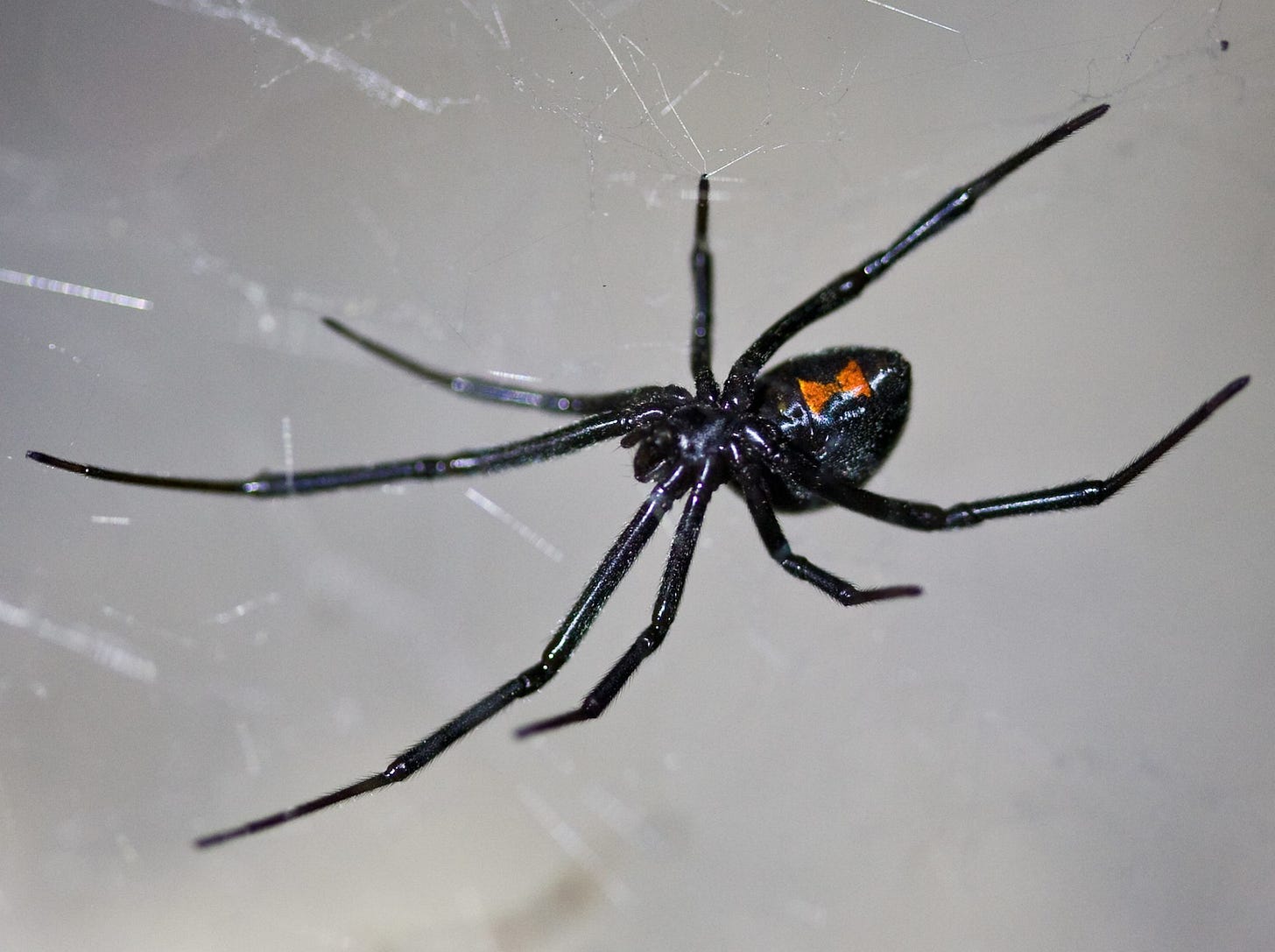There are a lot of little black spiders on this planet, and the vast majority of them pose absolutely zero threat to humans. But then there’s the black widow.
Identified by a red hourglass on its abdomen, the black widow is easily one of the most recognizable and most feared arthropods (insects, arachnids, and other invertebrates). And not without reason—black widows have a powerful neurotoxin (called latrotoxin) in their venom that can kill a human.
Fortunately, black widows have no good reason to want to bite a person, unless they’ve been backed into a corner themselves. And this means bites are relatively rare, and deaths by black widow even rarer. How rare, exactly? Well, I just spent some time trying to figure that out and I couldn’t find a single death linked to black widow venom. Which isn’t the same as saying that it never happens, but should at least make you feel better. (Not to get too dark on a Monday morning, but you’ll have a much easier time finding reports of dogs killing people. Several incidents have already occurred this year, which I will not be linking to.)
On the flip side of the equation, humans stomp black widows all the ding-dang time. Because while the animals pack a punch, they are still just itty bitty crunches beneath our boots and newspapers. And venom doesn’t mean much when your earthly existence can be reduced to a wet smudge against a floorboard.
But there’s another reason we should cut black widows a little slack. According to a new study, they’re being murdered in their homes on a regular basis.
Sympathy for the Black Widow
Scientists have noticed for a while now that out in the wild, black widows were getting outcompeted by another closely related spider known as the brown widow. While black widows are native to North America, brown widows are not, and are thought to have been introduced from Africa. (Here’s a handy guide for how to tell black widows apart from brown widows. It’s a little more complicated than you might think.)
Toe-to-toe, there are a number of reasons why brown widows seem to be doing better than their cousins. Brown widow females tend to be larger than black widow females, for instance, and both sexes of brown widow appear to reach sexual maturity faster than black widows. Brown widow females can also produce multiple egg sacs at a time, while black widows do just the one. So the brown widows are just sort of equipped to succeed.
And then there’s the violence.
In study published in the Annals of the Entomological Society today, scientists found that brown widows seem to search out black widows, then kill them.
This is particularly wild because the brown widows were significantly less violent when housed with red house spiders and triangulate cobweb spiders. But when they’re in the same room as a black widow, the brown widows get a crazy look in their eyes and go on a rampage. In one phase of the trial, subadult females of both species were placed together, and the brown widows killed the black widows 80 percent of the time.
Oh, and then the brown widows gobble them up.
What’s really interesting, say the researchers, is that the spiders hail from the same genus (known as Latrodectus). And while there are plenty of examples of non-native species waltzing into an ecosystem and outcompeting the natives, it’s another thing entirely for the non-native to selectively target and kill its closest cousins.
What Does It All Mean?
Now, before you start to worry about a new, super widow on the loose, experts say the brown widow’s bite is actually pretty mild when compared to the black widow.
What’s more, when it comes to humans at least, brown widows are even more shy than their already super shy cousins, the black widows.
“That brown widow spiders are bolder than black widows when it comes to ‘territorial disputes’ is interesting, because my experience with collecting brown widows is that they are extremely shy and curl up into a ball at the slightest disturbance,” says Catherine Scott, an arachnologist at McGill University in Montreal. “But of course that is a different context (I am a huge potential predator, whereas a black widow is only a slightly larger potential competitor or valuable prey item).”

Still, the fact that brown widows target black widows is “Very cool stuff!”, says Scott, who has worked with both species.
By the way, if you’re wondering how anyone becomes a person who regularly works with black widows, well, you should know that Scott is probably more like the rest of us than you realize.
“I was terrified of spiders as a kid, up until I started studying the vibratory communication of black widows when I was about 25,” she says. (For more on Scott’s spider-ific origin story, check out this podcast!)
By the way, Scott just had a super cool study published about candy striper spiders (d’aww!) and how they sneak up on resting wasps and murder them in their sleep (whoa!). Read more about all of that here!
While it’s not great news that brown widows are outcompeting black widows, ecologically speaking, any spider news is a good opportunity to remind us just how important these animals really are. (Yes, spiders are animals.)
“Spiders in general are important predators of insects (to the tune of >400,000 metric tonnes annually) and prey for other animals like birds, and they are key members of almost every terrestrial ecosystem on Earth, from the Arctic tundra, to the slopes of Mount Everest, to the deserts, beaches, rainforests, agricultural fields, and even our homes and gardens,” says Scott in an email. “They are far more helpful to humans (for instance by eating insects that would otherwise be eating our crops and gardens) than they are harmful, and they are also beautiful animals with fascinating behaviour!”
I know, for those of you with arachnophobia, rational thought is unlikely to dissuade that deep, primordial fear that swells up when you see a hairy ball full of legs. But maybe I can leave with something that will soften the terror every so slightly: A bunch of peacock spiders dancing their pretty little hearts out.





